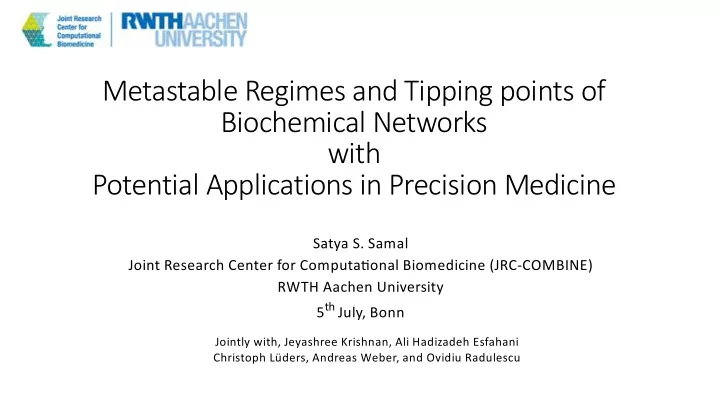

Metastable Regimes and Tipping points of Biochemical Networks with Potential Applications in Precision Medicine Satya S. Samal Joint Research Center for Computa7onal Biomedicine (JRC-COMBINE) RWTH Aachen University 5 th July, Bonn Jointly with, Jeyashree Krishnan, Ali Hadizadeh Esfahani Christoph Lüders, Andreas Weber, and Ovidiu Radulescu
Tipping points / Cri-cal transi-ons • Disease: Devia&on of a few system parameters from ‘normal’ state qualita&vely affec&ng system behavior Risk zone healthy System response disease p order parameter • Sudden change in a dynamical system's state Bifurca&ons, Phase Transi&ons, … § Can be predic&ve § MAPK cascade : Huang and Ferrell 96 Chen et al. (2012). Dakoset al. (2012). Schefferet al. (2009).
Precision medicine • Predict therapy outcome (at individual/micro-segments). • Extrapola<on of mathema<cal models. • Heterogeneity of pa<ents. • Pa<ent specificity parameters in models. • Non-sta<onary <me series. • Non constancy of underlying biological mechanism due to (clinical/biological) perturba<ons. • Altera<ons in signalling pathways (such as MAPK/PI3K). • Pathway redundancy and mul<ple feedback regula<on are obstacles against cancer targeted therapies.
Metastable regimes • Trajectories of ODEs consist of transi0ons between slow regions. • Slow regions are denoted by low dimensional manifolds are called metastable regimes. • In our work, the metastable regimes correspond to tropical equilibra0on (TE) solu0ons. Ø Slowness follows from the compensa0on of Crazy quilt: Representation of MRs. Dominant vector fields (red dominant monomials. arrows) confine the trajectory to low dimensional patches on Ø Tropical geometry provides a framework to which act weak uncompensated vector fields (blue arrows). compute such states.
Tropical equilibra.on solu.ons • Order analysis of ODEs " 1 = −" 16 +" 13 " 2 −" 13 +" 1 " 22 Ø ̇ Ø Order of the variables Ø " 1 = " 1 ε a 1 , " 2 = " 2 ε a 2 Ø Order of the monomials Ø " 16 = " 16 ε 6a 1 Ø " 13 " 2 = " 13 " 2 ε 3a 1 +a 2 Ø " 13 = " 13 ε 3a 1 Ø " 1 " 22 = " 1 " 22 ε a 1 +2a 2 • Metastable regimes for x 1 andx 2 results into following equilibraCon condiCon Ø min(3a 1 +a 2 a 1 +2a 2 ) = min(6a 1 ,3a 1 ) • Branches : Equivalence classes of TE soluCons. Ø (Closure) for each branch there exists a unique convex polytope. Branches of tropical solutions correspond to half lines • Minimal branch : Branch corresponding to maximal (orthogonal to the thick edges of newton polytope) and are given polytope with respect to inclusion. by a1 = a2 >= 0, a1 <=0, a2 = 5/2 a1 .
Tropical minimal branches Rescaled system Tropical equilibra.ons (TE) are solu.on of the below for orders a
Sensi&ve/Robust parameters Networks Models (along with kine>c rate parameters) Compute tropical equilibrations (minimal branches) Vary parameters and compute their effect on the minimal branches Distance for the j parameter along X m variable. Full distance for the j parameter Samal et al. (submiEed)
Results: Network model • The model was mo4vated by experimental works on the Heregulin s4mulated ErbB receptor and demonstrates the Akt-induced inhibi4on of the MAPK pathway via phosphoryla4on of Raf-1. • This CRN model has 33 species and 34 reac4ons. 21 reac4ons have Michaelis- Menten kine4cs and 12 have mass ac4on kine4c laws. Hatakeyama, M. et al (2013) Biomodels: BIOMD0000000146
Results: Distances Robust parameters Normalised distances for select parameters. D 1 full distance, D 2 distance along MAPKPP axis, Sensitive parameters D 3 distance along AKTPiPP axis. DistribuCon of D 1 distances.
Change in protein data concentrations • Quan%fy the overlap with tropical sensi%vity scores: • Area under the curve (AUC): • Breast cancer data:0.55 • Skin Cutaneous Melanoma: 0.85 • Breast cancer subtypes: (average): 0.72 *0.50 is random guessing. Sta%s%cal comparison of disease versus healthy samples from BRCA and SKCM cancers. A low p-value suggests significant change in rela%ve concentra%ons.
So#ware • PtCut - Check Christoph Lüders’s webpage: h9p://wrogn.com/ptcut
Future work (SYMBIONT) • Compute robustness for different models. • Multi-parameter perturbation (efficient sampling techniques). • Better distance measures. • Parametric solving • Without fixing the parameter orders. • Learn parameters from experimental ( noisy ) data. • Tropical interpolation. • Integrate disease data/networks. • Do we have the “executable” models ?
Conclusions • A “global” method to test robustness of biochemical reaction networks. • Dependence of change in tropical solutions w.r.t. model parameters. • A potential in-silico tool to identify putative drug targets. • Provides a ranked list of targets for biologists for experimental validation. • Comparison with protein concentration data. • Cancer vs Healthy data. • Future outlook in context of SYMBIONT.
Thank you
Recommend
More recommend